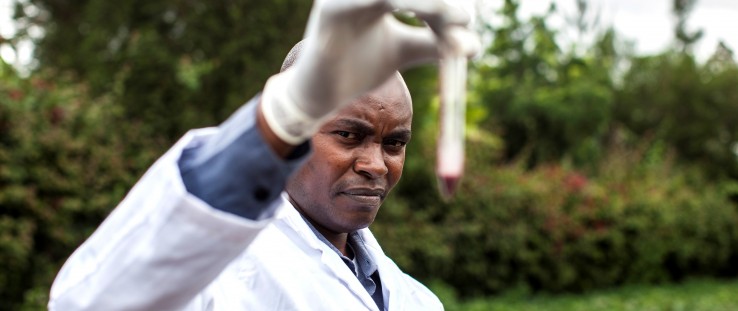 An agricultural extension worker inspects the color of a pH soil test.
Mackenzie Knowles-Coursin, USAID
An agricultural extension worker inspects the color of a pH soil test.
Mackenzie Knowles-Coursin, USAID
 An agricultural extension worker inspects the color of a pH soil test.
Mackenzie Knowles-Coursin, USAID
An agricultural extension worker inspects the color of a pH soil test.
Mackenzie Knowles-Coursin, USAID
Growing up in Njoro, Kenya, in the 1970s, Fredrick Muthuri remembers working alongside his mother and brothers on their farm, planting maize.
His family’s farm neighbored big plots owned by commercial farmers.
“I used to wonder why there was such a big disparity in yields between what they used to get and what we used to get, because our life was built around planting,” he says.
It wasn’t until many harvests later that Muthuri and his family learned that a successful farmer always tests his soil to determine which fertilizers to use. “A soil test is the thermometer of agricultural production. Like when you go to the hospital and they take your temperature, it’s the first stage of finding out the problem with your soil,” says Muthuri.
Now in his 40s, Muthuri is a botanist and chemist. He is laser-focused on using soil science to help farmers maximize their productivity.
In 2004, he started a small soil testing lab, Quest Technologies, which performed basic soil analyses for large exporters. But Muthuri felt there was more he could offer, especially to small-scale farmers unable to afford the $35 (3,000 Kenyan shillings) analyses, and who didn’t have the time or resources to travel back and forth to a traditional laboratory.
In 2012, Muthuri developed a simple, cheap, mobile soil testing concept. Soil kits were supplied to local agricultural and veterinary businesses, or agro-vets. Extension workers used these kits to provide on-farm soil testing for their network of local farmers for about $12 (1,000 KSh). The raw results of the 45-minute test are given to the farmer and entered into an online platform, which calculates a customized fertilizer recommendation within minutes. If the fertilizer is unavailable in the farmer’s area, Quest can deliver a custom blend to the local agro-vet. Smallholder farmers will be able to boost their yields by 25 percent to 100 percent, and potentially increase their income by about $500 per year.
Creative and open-minded Kenyans like Muthuri are not waiting for someone else to solve their problems. They are jump-starting development with ideas that have the potential to improve the lives of other Kenyans across the country.
Muthuri pitched his solution to USAID/Kenya’s Feed the Future Innovation Engine, and is receiving the support he needs to pilot his idea. Launched in 2012, the Engine is attracting scalable ideas that have the potential to transform agriculture in Kenya through one of the country’s most valuable assets—the farmer.
The Engine harnesses the venture capital model to fuel ideas and give young enterprises room to take risks, build pilots, develop technology, and test and expand innovations for widespread impact. Of equal importance to capital, innovators also receive technical assistance, coaching and mentoring.
“Whether it’s through local challenges like the Kenya Feed the Future Innovation Engine, or global Grand Challenges, Kenya’s brightest minds are bringing their most promising development solutions to the table,” says USAID/Kenya Mission Director Karen Freeman.
Kenyan innovations have also been winners of USAID’s Grand Challenges for Development, with concepts that can save the lives of more mothers and newborns through early integration of family planning during the postpartum stage, and the creation of culturally relevant learning tools that improve literacy for primary school students in low-income areas. (See sidebar below.)
Incubate to Innovate
Fertilizer increases productivity and farmers’ incomes, making it an integral part of the blueprint to achieve food security. “Having the right fertilizer, for the right crop, that supplies the right nutrients to the soil is critical for optimal yields,” says Muthuri.
To date, the soil testing kit has been used to increase the productivity of nearly 7,000 farmers. The concept is still in the early stages, and Muthuri and his team are working with USAID to fine-tune the innovation and pilot it with 3,000 additional farmers. Ultimately, he hopes to roll it out across the country.
Mobile soil testing has the potential to improve the incomes and lives of over 60,000 smallholder farmers and their families. It can also improve the quality of agricultural extension in Kenya, giving extension workers an effective diagnostic tool to help farmers solve their production problems.
“Because the information is given directly to the farmers on the ground, we’ve found that it reaches more people. It’s a full farm solution,” says Michael Mumbu, owner of Mbaitu Agro-Vet.
Mumbu has used the soil testing kit to work with smallholder farmers in Makueni. Farmers call him when they have a problem, and he is able to carry out a soil test, identify the issue, and recommend a solution within the same day—at a third of the cost of classic laboratories and a fraction of the time.
Hello, CoolBot
While increasing productivity is an important strategy to boost incomes for smallholder farmers, it’s not the only solution. Beyond achieving record yields, farmers also need assurance that their produce is not lost to spoilage or pests before being sold at market.
Postharvest losses in Kenya can range from 10 percent to 50 percent, depending on the type of produce.
Mango farmers in Makueni County, Kenya, know the impacts of postharvest waste firsthand.
“There’s so much wasted after harvest because we can’t store the mangoes long enough to find a market,” says Wilifred Mailu, secretary of the Kawala Small-Scale Horticultural Farmers Group in Makueni.
The fleshy, tropical fruit has a short season, and must be plucked immediately after ripening. Otherwise, the fruit will fall from the tree when it has rotted. After the mangoes in Makueni are harvested, farmers store the fruit in their homes, waiting to sell. They have four days, at most, to find a buyer.
“If we don’t have buyers, we end up selling at throwaway prices,” says Mailu.
Middlemen, or brokers, buy the mangoes from the farmers for low prices, way below market value, and sell to buyers at a much higher cost, pocketing the difference.
“The middlemen make more money than us, without a single mango tree. They harvest what they haven’t planted and that’s very wrong,” says Mailu. “The family goes without money. They are unable to pay school fees when they should’ve been able to, but because of the loss, their children do not get an education.”
In 2012, Jane Ambuko, head of the horticulture unit at the University of Nairobi, came up with a solution. In her postharvest conservation research, she discovered an American innovation called the CoolBot, a low-cost alternative to a standard cold room.
“It will give farmers a way to preserve their mangoes until the price is better,” says Ambuko.
The CoolBot has been piloted in Bangladesh, India, Uganda, Senegal and Tanzania.
The technology turns a standard domestic window air conditioner with a thermostat into a cooling solution that maintains optimal storage temperatures for produce. At around $3,000, the entire system, including the insulated room, air conditioner and CoolBot unit, is less than half the cost of a commercial cold storage room.
The CoolBot transfers any insulated room into a walk-in cooler. “You’d rather invest in a properly insulated structure, because then power usage is low and the running costs are minimal,” says Ambuko.
Ambuko and her team at the University of Nairobi pitched the CoolBot to USAID’s Kenya Feed the Future Innovation Engine and have received support to pilot the solution in three Kenyan counties. They are exploring ways to add value to the technology, such as incorporating solar panels that allow the CoolBot to run in areas located off the electricity grid, and building cost-effective makeshift cold rooms from local materials.
“What we’re trying to do is domesticate it in Kenya, to see what works under Kenyan conditions,” says Ambuko. “Our U.S. partner is going to come and help us modify and perfect it.”
The CoolBot not only has the potential to raise the incomes of farmers, it also gives them a central place to bulk their mangoes and allows them to diversify and venture into other high-value perishables like French beans, tomatoes and leafy green vegetables like kale.
“This is like the Messiah we’ve been waiting for,” says Joseph Mutua, a mango farmer in Makueni. “If we could sustain the shelf life of our fruit after we have harvested them, it will really go a long way to assisting us.”
USAID’s Grand Challenges for Development: Kenyan Innovations
Saving Lives at Birth: Jacaranda Health, 2012 Winner
Jacaranda Health is testing promising strategies that have the potential to improve the quality of postnatal care and integrate family planning services into the postpartum period. Family planning allows women to delay, space or limit future pregnancies, making it a powerful tool in reducing maternal deaths.
All Children Reading: ComTech, University of Nairobi, 2012 Winner
The University of Nairobi has developed and piloted an early grade reading instruction curriculum that strengthens the ability of teachers to teach and prepare students for reading in the primary years through the use of high quality, multi-genre, culturally relevant and age-appropriate instructional materials and resources in English and Kiswahili.







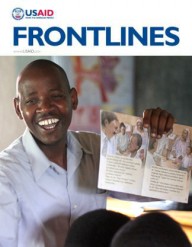

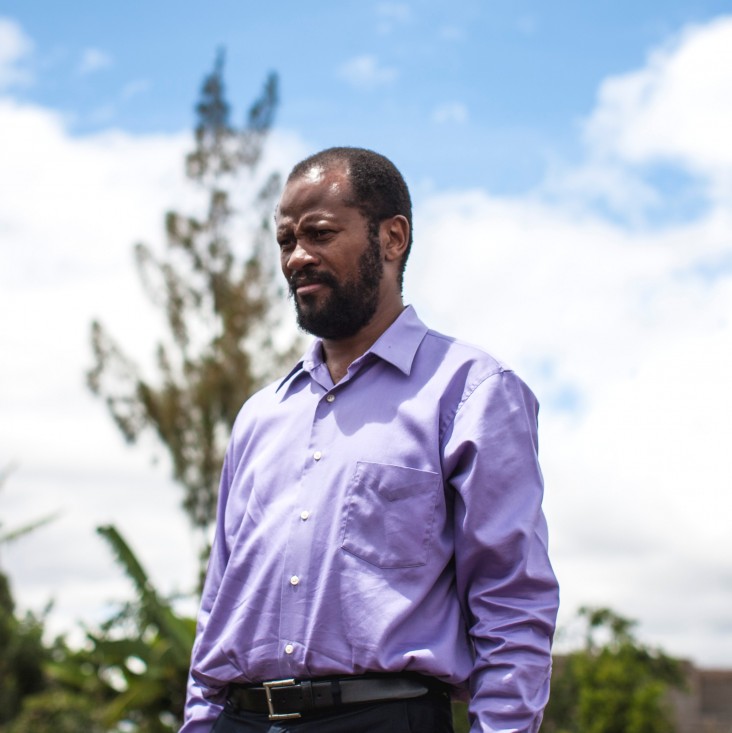
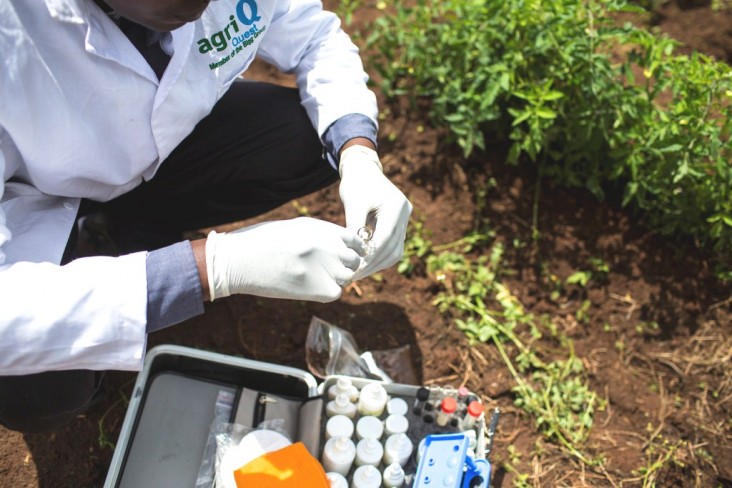
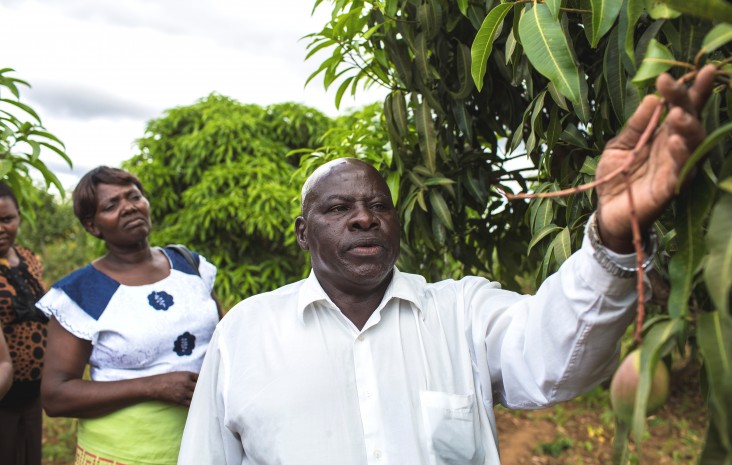
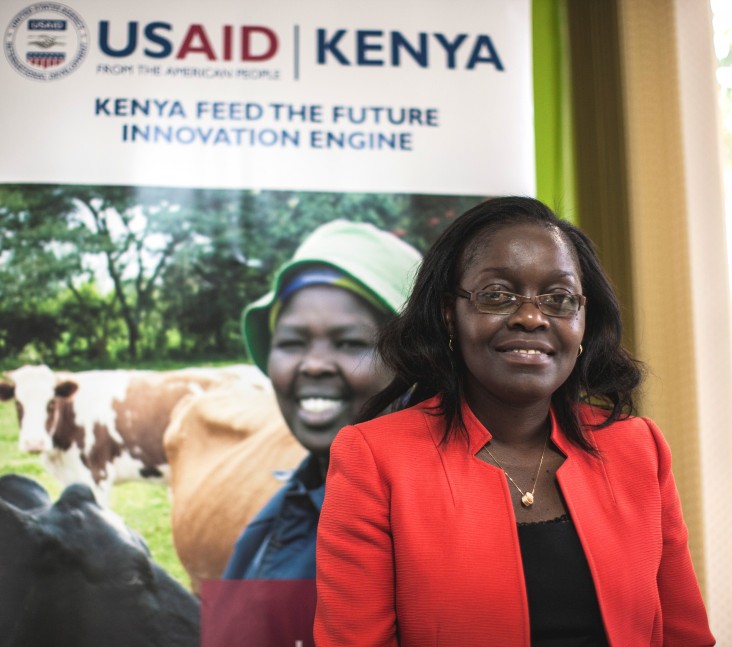
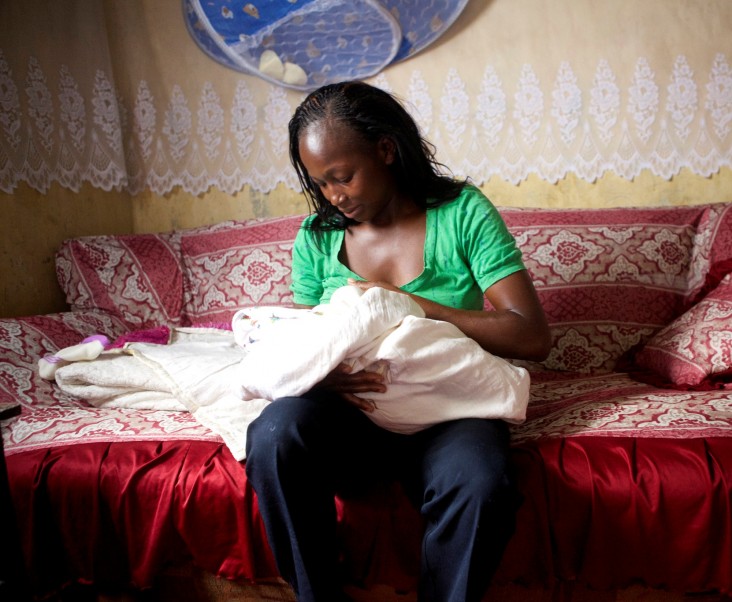
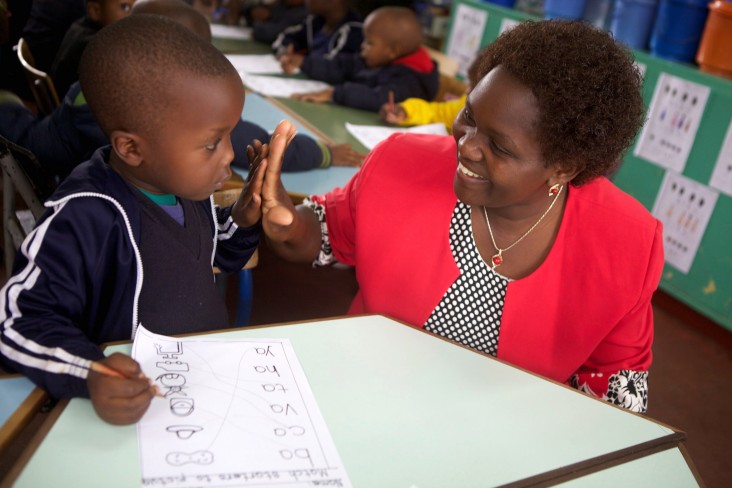
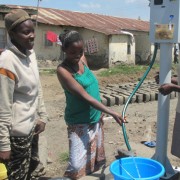


Comment
Make a general inquiry or suggest an improvement.